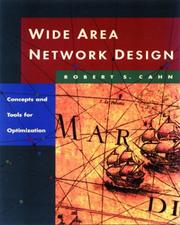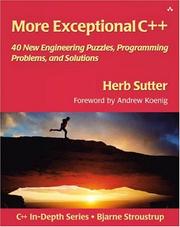| Listing 1 - 10 of 157 | << page >> |
Sort by
|

ISBN: 1558604588 9781558604582 Year: 1998 Publisher: Los Altos Kaufmann
Abstract | Keywords | Export | Availability | Bookmark
 Loading...
Loading...Choose an application
- Reference Manager
- EndNote
- RefWorks (Direct export to RefWorks)

ISBN: 0444512489 Year: 2003 Publisher: Amsterdam Elsevier
Abstract | Keywords | Export | Availability | Bookmark
 Loading...
Loading...Choose an application
- Reference Manager
- EndNote
- RefWorks (Direct export to RefWorks)
Dissertation
ISBN: 9789056828097 Year: 2007 Publisher: Leuven Katholieke Universiteit Leuven
Abstract | Keywords | Export | Availability | Bookmark
 Loading...
Loading...Choose an application
- Reference Manager
- EndNote
- RefWorks (Direct export to RefWorks)
Oppervlakkenregistratie duidt op de bepaling van de geometrische relatie tussen twee of meerdere oppervlakken. Het is een algemene technologie en strategie om een brede waaier van 3D computergebaseerde modellering en reconstructieproblemen op te lossen. Wij presenteren een robuuste statistisch gebaseerde oppervlakregistratie methodologie die de afstand tussen oppervlakken minimaliseert over de parameters die de geometrische transformatie definiëren. Hiervoor gebruiken we een geheugen efficiënte, continue, zacht verlopende en analytische impliciete oppervlakvoorstelling, welke interessante eigenschappen incorporeert voor registratiedoeleinden. Robuustheid tegen ruis of kleine fouten en onverklaarbaarheden of grote fouten wordt bekomen m.b.v een maximum a-posteriori formulering van de registratie, dewelke statistische verklaarbare en onverklaarbare proces modellen bevat. De hoofdapplicatie van het voorgestelde registratieraamwerk is forensische gezichtsreconstructie welke oogt op het genereren van een gezichtsenveloppe schatting geassocieerd met een onbekende schedel voor identificatiedoeleinden. Traditionele manuele reconstructiemethoden bestaan erin om fysisch het gezicht te boetseren op de droge schedel m.b.v klei of plasticine. Wij presenteren een (semi-)automatische computergebaseerde gezichtsreconstructie methode die zowel consistent is als objectief. De techniek is gebaseerd op een statistisch gezichtsmodel betreffende de interrelatie van gezichtsvorm en zachte weefsel diktes gemeten in een voorgedefinieerde verzameling van anatomische merkpunten op de schedel. Het model kan bekeken worden als een elastisch masker met elastische halve bollen aan de binnenkant, dat vervolgens vervormd wordt naar de schedel toe zodat de halve bollen het schedeloppervlak raken. De elasticiteit van het masker en de bollen is gebaseerd op een statistische waarschijnlijkheid zoals die geleerd werd uit een databank met gezichtsschedel relaterende gegevens van bijna 400 levende personen. De resultaten geven aan dat de voorgestelde statistisch gebaseerde reconstructietechniek een waardige vervanger is voor huidige procedures. Surface registration refers to the establishment of the geometrical relationship between two or more surfaces. It is a key enabling technology to solve a wide range of 3D computer-based modeling and reconstruction problems. We present a robust, statistical, surface registration framework that optimizes an inter-surface distance measure over the parameters that define the geometric transformation. We use a memory efficient, continuous, smooth and analytical implicit surface representation, which has particularly interesting properties for registration purposes. Robustness against noise and outliers of the surface models during registration is obtained using a Maximum a Posteriori (MAP) formulation including a statistical inlier- and outlier-process model. The main application of the proposed framework is forensic craniofacial reconstruction which aims at estimating the face associated to an unknown skull specimen for victim identification. Traditional methods are based on a manual 3D reconstruction by physically modeling a face on a skull replica with clay or plasticine. We present here a computer-based (semi-)automated reconstruction method that is both consistent and objective. It builds on a statistical model of the interrelationship between facial shape and soft-tissue thicknesses as measured on a predefined set of landmark points on the skull. The model can be considered as an elastic mask with elastic hemi-spherical dowels on the inside of the mask at the landmark locations, which is subsequently fitted to the skull such that the virtual dowels touch the skull. The elastic deformation of the model is based on the statistical likelihood as learned from a database of nearly 400 subjects. The results indicate that the proposed statistical craniofacial reconstruction approach is a very promising substitute for current procedures. Forensische gezichtsreconstructie genereert een gezichtsenveloppe schatting geassocieerd met een onbekende schedel voor identificatiedoeleinden. Traditionele manuele reconstructiemethoden bestaan erin om fysisch het gezicht te boetseren op de droge schedel m.b.v klei of plasticine. Wij presenteren een (semi-)automatische computergebaseerde gezichtsreconstructie methode die zowel consistent is als objectief. De techniek is gebaseerd op een statistisch gezichtsmodel betreffende de interrelatie van gezichtsvorm en zachte weefsel diktes gemeten in een voorgedefinieerde verzameling van anatomische merkpunten op de schedel. Het model kan bekeken worden als een elastisch masker met elastische halve bollen aan de binnenkant, dat vervolgens vervormd wordt naar de schedel toe zodat de halve bollen het schedeloppervlak raken. De elasticiteit van het masker en de bollen is gebaseerd op een statistische waarschijnlijkheid zoals die geleerd werd uit een databank met gezichtsschedel relaterende gegevens van bijna 400 levende personen. De resultaten geven aan dat de voorgestelde statistisch gebaseerde reconstructietechniek een waardige vervanger is voor huidige procedures. Forensic craniofacial reconstruction aims at estimating the face associated to an unknown skull specimen for victim identification. Traditional methods are based on a manual 3D reconstruction by physically modeling a face on a skull replica with clay or plasticine. We present here a computer-based (semi-)automated reconstruction method that is both consistent and objective. It builds on a statistical model of the interrelationship between facial shape and soft-tissue thicknesses as measured on a predefined set of landmark points on the skull. The model can be considered as an elastic mask with elastic hemi-spherical dowels on the inside of the mask at the landmark locations, which is subsequently fitted to the skull such that the virtual dowels touch the skull. The elastic deformation of the model is based on the statistical likelihood as learned from a database of nearly 400 subjects. The results indicate that the proposed statistical craniofacial reconstruction approach is a very promising substitute for current procedures.
Dissertation
ISBN: 9789460180279 Year: 2009 Publisher: Heverlee Katholieke Universiteit Leuven. Faculteit Ingenieurswetenschappen
Abstract | Keywords | Export | Availability | Bookmark
 Loading...
Loading...Choose an application
- Reference Manager
- EndNote
- RefWorks (Direct export to RefWorks)
Nederlands Hogesnelheidsmechanismen vormen het dynamische hart van veel moderne machines. In een verbrandingsmotor, bijvoorbeeld, zorgt een krukdrijfstangmechanisme voor de omzetting van de heen-en-weer gaande beweging van de zuigers in een roterende beweging van de krukas. Ook in andere hogesnelheidsmachines zoals weefmachines, verpakkingsmachines en drukpersen vormen mechanismen een essentieel onderdeel. Bewegende mechanismen kunnen leiden tot ongewenste trillingen van de machine en omgeving, zoals de werkvloer of naburige gebouwen. Eén van de strategieën om die trillingen te onderdrukken is door toevoeging van balancerende tegengewichten. ' Het bepalen van de optimale vorm, plaats, gewicht, etc. van de tegengewichten geeft aanleiding tot een optimalisatieprobleem. Eerder onderzoek aan de K.U.Leuven, heeft aangetoond dat het mogelijk is om het probleem "convex" te formuleren, wat zeer interessante numerieke eigenschappen biedt. ' Dit doctoraat ontwikkelt op basis van deze concepten een praktische (industrieel) algemeen toepasbare methode voor het balanceren van vlakke en ruimtelijke complexe mechanismen. Een procedure werd ontwikkeld die de ontwerpers toelaat het effect van verschillende parameters te kwantificeren om hieruit een overwogen keuze te kunnen maken. ' Deze methode is toegepast voor het balanceren van het grijpermechanisme van een weefmachine, dit, in samenwerking met Picanol N.V. Omwille van de spectaculaire resultaten is het gebalanceerde grijpermechanisme meteen in productie gegaan en maakt nu deel uit van de nieuwe OptiMaX grijperweefmachine die in april 2007 gelanceerd is. ' English High-speed mechanisms are often used in modern machinery. In combustion engines, for instance, a crank-slider mechanism transforms the reciprocating motion of the pistons into the rotation of the crankshaft. In other high-speed machinery such as weaving machines, packaging machines and presses high-speed mechanisms are essential. A moving mechanism can result in undesired vibrations of the machine and its surroundings, such as the factory floor and neighboring buildings. One strategy to suppress these vibrations is by adding counterweights to the mechanism. ' Determining the optimal shape, position, mass, etc. of the counterweights constitutes an optimization problem. Previous research at the K.U.Leuven, proved that it is possible to formulate the problem as a so-called ``convex" optimization problem which has interesting numerical properties. ' Based on these concepts, this research develops an industrially applicable methodology to design counterweights for complex planar and spatial mechanisms. A procedure was developed to quantify the effect of several design parameters and help designers make a sensible choice. ' The presented framework was successfully applied to an industrial application consisting of the rapier drive mechanism of a weaving machine, in cooperation with Picanol N.V. Due to spectacular results, the optimized rapier drive mechanism was quickly included in a new generation of weaving machines, the OptiMax, launched in April 2007.
Book
ISBN: 3540081062 3662087057 9783540081067 Year: 1977 Publisher: Berlin Springer
Abstract | Keywords | Export | Availability | Bookmark
 Loading...
Loading...Choose an application
- Reference Manager
- EndNote
- RefWorks (Direct export to RefWorks)
Book
ISBN: 3540170332 3642955061 Year: 1986 Publisher: Berlin Springer
Abstract | Keywords | Export | Availability | Bookmark
 Loading...
Loading...Choose an application
- Reference Manager
- EndNote
- RefWorks (Direct export to RefWorks)
Dissertation
ISBN: 9789460180484 Year: 2009 Publisher: Leuven Katholieke Universiteit Leuven
Abstract | Keywords | Export | Availability | Bookmark
 Loading...
Loading...Choose an application
- Reference Manager
- EndNote
- RefWorks (Direct export to RefWorks)
Dit proefschrift heeft betrekking op het optimale ontwerp van mechatronische systemen dat vereist dat tussen de structurele en de controleparameters op een geïntegreerde wijze een optimale keuze moet gemaakt worden met betrekking tot de ontwerpspeci caties. Om dit te bereiken geeft dit werk computerondersteunde hulpmiddelen voor het geïntegreerde ontwerp van mechanische systemen. Bij de behandeling van een geïntegreerd ontwerp worden twee belangrijke uitdagingen vastgesteld: de modellering vanwege hun multidisciplinaire karakter en de optimalisatie vanwege hun niet-convexe aard.Om de eerste uitdaging aan te pakken, zijn er richtlijnen voor het moduleren van mechatronische systemen voorgesteld de rekening houder met de exibiliteit, de beweging van het systeem en de controleactie. Voor het verkrijgen van een beknopte beschrijving van het systeem werden modelreductieprocedures gebruikt. Voor de tweede uitdaging werden twee strategieën onderzocht: de genestelde en de directe ontwerpstrategie. De genestelde ontwerpstrategie combineert niet-lineaire optimalisatiemethoden met modelgebaseerde controleontwerp technieken. De direkte ontwerpstrategie beschouwt gelijktijdig controle en structurele parameters gebruik makend van niet-lineaire of genetische optimalisatie algoritmes. Drie case studies werden onderzocht: een vibro-acoustisch systeem en twee pick-and-place machines met serieel en parallel kinematische kringen. De pick-and-place machines hebben een configuratieafhankelijke dynamica die onvermijdelijk het gedrag en de stabiliteit van het controlesysteem beïnvloedt. Dit laat vermoeden dat een genesteld ontwerp beter past voor deze taak. Hieruit kan besloten worden dat een optimaal ontwerp slechts kan bekomen worden als zowel de controle als de structuurparameters op een geïntegreerde wijze beschouwd worden. This thesis concerns the optimal design of mechatronic systems, which requires that, among the structural and control parameters, an optimal choice has to be made with respect to design specifications in an integrated way. To accomplish that, this work provides tools to computer-aid the integrated design of mechatronic systems. Two main challenges have been identified when dealing with integrated design: modeling due to their multidisciplinary nature and optimization due to their non-convex nature. To overcome the former issue, guidelines for modeling mechatronic systems considering the system flexibilities, the system motion and the control action have been proposed. These parametric models may easily contain several degrees-of-freedom and be unsuitable for control design purposes. To obtain a concise description of the system, model reduction procedures have been employed. To tackle the later issue, two strategies have been investigated: the nested and the direct design strategies. The nested design strategy combines nonlinear optimization methods and the model-based control design techniques. The direct design strategy considers, simultaneously, control and structural parameters using non-linear optimization or genetic algorithms. Three case studies have been exploited: a vibro-acoustic system and two pick-and-place machines, containing serial and parallel kinematic chains. The pick-and-place machines present configuration-dependent dynamics, which inevitably affect the performance and the stability of the control system. Important issues have been identified when the direct strategy is employed for designing a mechatronic system with configuration-dependent dynamics, suggesting that the nested design strategy suits better this task. It can be concluded that the optimal design of mechatronic systems can only be accomplish when control and structural parameter are considered in an integrated way. Dit proefschrift heeft betrekking op het optimale ontwerp van mechatronische systemen dat vereist dat tussen de structurele en de controleparameters op een geïntegreerde wijze een optimale keuze moet gemaakt worden met betrekking tot de ontwerpspeci caties. Om dit te bereiken geeft dit werk computerondersteunde hulpmiddelen voor het geïntegreerde ontwerp van mechanische systemen. Bij de behandeling van een geïntegreerd ontwerp worden twee belangrijke uitdagingen vastgesteld: de modellering vanwege hun multidisciplinaire karakter en de optimalisatie vanwege hun niet-convexe aard.Om de eerste uitdaging aan te pakken, zijn er richtlijnen voor het moduleren van mechatronische systemen voorgesteld de rekening houder met de exibiliteit, de beweging van het systeem en de controleactie. Voor het verkrijgen van een beknopte beschrijving van het systeem werden modelreductieprocedures gebruikt. Voor de tweede uitdaging werden twee strategieën onderzocht: de genestelde en de directe ontwerpstrategie. De genestelde ontwerpstrategie combineert niet-lineaire optimalisatiemethoden met modelgebaseerde controleontwerp technieken. De direkte ontwerpstrategie beschouwt gelijktijdig controle en structurele parameters gebruik makend van niet-lineaire of genetische optimalisatie algoritmes. Drie case studies werden onderzocht: een vibro-acoustisch systeem en twee pick-and-place machines met serieel en parallel kinematische kringen. De pick-and-place machines hebben een configuratieafhankelijke dynamica die onvermijdelijk het gedrag en de stabiliteit van het controlesysteem beïnvloedt. Dit laat vermoeden dat een genesteld ontwerp beter past voor deze taak. Hieruit kan besloten worden dat een optimaal ontwerp slechts kan bekomen worden als zowel de controle als de structuurparameters op een geïntegreerde wijze beschouwd worden. This thesis concerns the optimal design of mechatronic systems, which requires that, among the structural and control parameters, an optimal choice has to be made with respect to design specifications in an integrated way. To accomplish that, this work provides tools to computer-aid the integrated design of mechatronic systems. Two main challenges have been identified when dealing with integrated design: modeling due to their multidisciplinary nature and optimization due to their non-convex nature. To overcome the former issue, guidelines for modeling mechatronic systems considering the system flexibilities, the system motion and the control action have been proposed. To tackle the later issue, two strategies have been investigated: the nested and the direct design strategies. The nested design strategy combines nonlinear optimization methods and the model-based control design techniques. The direct design strategy considers, simultaneously, control and structural parameters using non-linear optimization or genetic algorithms. Three case studies have been exploited: a vibro-acoustic system and two pick-and-place machines, containing serial and parallel kinematic chains. These case studies illustrate the benefits of the integrated design of mechatronic systems.
Dissertation
ISBN: 9056827103 Year: 2006 Publisher: Leuven Katholieke Universiteit Leuven
Abstract | Keywords | Export | Availability | Bookmark
 Loading...
Loading...Choose an application
- Reference Manager
- EndNote
- RefWorks (Direct export to RefWorks)
Book
ISBN: 3540094377 Year: 1979 Publisher: Berlin Springer
Abstract | Keywords | Export | Availability | Bookmark
 Loading...
Loading...Choose an application
- Reference Manager
- EndNote
- RefWorks (Direct export to RefWorks)

ISBN: 020170434X Year: 2002 Publisher: Boston Addison-Wesley
Abstract | Keywords | Export | Availability | Bookmark
 Loading...
Loading...Choose an application
- Reference Manager
- EndNote
- RefWorks (Direct export to RefWorks)
Programming --- C++ (Computer program language) --- C++ (Langage de programmation) --- 519.68 --- 681.3*J2 --- Computer programming --- Physical sciences and engineering (Computer applications) --- 681.3*J2 Physical sciences and engineering (Computer applications) --- 519.68 Computer programming
| Listing 1 - 10 of 157 | << page >> |
Sort by
|

 Search
Search Feedback
Feedback About
About Help
Help News
News